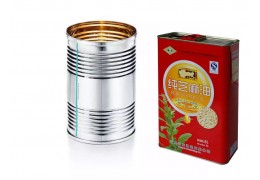Hochwertige...
History of food tin cans
In 1804, the Frenchman Nicolas Appert, in response to the need for French warships in the Franco-Prussian War to transport food at high temperatures for long periods of time, invented food in wide-mouth bottles, lightly stoppered with a cork, and after cooking and washing for 30-60 minutes, the bottle was tightly sealed. .
After the test results, the effect of the peak period was reached, and in 1810, he was awarded a bonus of 12,000 francs by the Emperor Napoleon of France.
In June 1810, Nicolas Appert published the long-term preservation of animals and plants.
In 1810, the British Peter Durand used tinplate cans and food storage methods to obtain the ancestor of the British government's special tinplate cans.
In 1821, the British wWilliam Underwood set up a factory in Boston, England to produce bottled canned fruits for export
In 1825, Thomas Kensett's "Canning Process and Container" was licensed by the United States.
In 1847, American Allen Tailor invented cupping.
In 1874, A.K. Shriver completed the design of the sterilizer, and the sterilization operation was improved.
In 1877, the canning machine was invented, and the canning industry gradually became mechanized.
In 1896, American Chales Ams invented liquid sealant.
In 1897, American Julis Bren Zinger invented the sealing glue coating machine.
Current Status of the Canned Food Industry in Taiwan, China
In the 1980s, there were more than 200 canning factories in Taiwan. Most of the industries were located near Changhua County and Taichung County. The products were mainly fruit and vegetable cans, followed by aquatic products and livestock products, of which pineapples, mushrooms, asparagus, and tangerines The bamboo shoots are a large stock, and the foreign arrows go to Europe, the United States, Japan and other places, and they obtain about US$300-500 million in foreign exchange each year, which contributed a lot to the early economic development of Taiwan.
In recent years, Taiwan's raw materials are expensive, wages have been rising, and the cost of canned food has increased relatively. The export market has been gradually replaced by developing countries. The export market loses its competitive advantage, and the development of canned food for domestic sale is the direction of our current efforts. Peanut gluten, flower melon sauce, and snacks such as eight-treasure porridge, canned peanuts, canned fruit juice and other products can meet the needs of Chinese people.
What is canned food?
In our daily life, in order to prolong the preservation period of food, smart humans have come up with many methods for thousands of years, such as tobacco, sun exposure, salting and so on. The pot storage technology is undoubtedly the youngest, starting in 1810, less than 200 years ago.
In 1809, world trade was prosperous, and seafarers who had lived on ships for a long time fell ill because they could not eat fresh vegetables, fruits and other foods, and some also suffered from scurvy that threatened life. What should we do? The French Napoleon government used it. A huge bonus of 12,000 francs seeks a way to save food for a long time.
Many people have invested in research activities in order to win awards. Among them is Apel, a Frenchman who runs secret food. He worked as a worker in a pickled vegetable factory, a factory, a candy store and a restaurant, and later became a chef. When he was selling foods such as fruit syrup and wine, he found that some tended to go bad, while some were not easy to go bad. He also accidentally discovered that if the food sealed in a glass container is properly heated, it is not easy to go bad. Great inspiration, so Asir responded to the government's reward and conducted a special study on food preservation methods.
After ten years of arduous research, he finally succeeded in 1804. His method is: process the food, put it in a jar, place it in boiling water for 20-50 minutes, and put it in a sealed tank. Preserving food for a long time without decay and deterioration, this is the prototype of modern canned food
In this way, the earliest canned food appeared. Abel was rewarded by the French government and warmly welcomed by the seamen.
Soon after Appel's glass cans came out, the British were made into tinplate cans by Durant and obtained a patent in the United Kingdom. At the beginning of the 191st century, canning technology spread to Guan, and appeared in Boston, New York and other places. Cannery, in 189, American Henry Evans opened an unprecedented cannery. In 1862, French biologist Pasteur published a paper, justifying that the main reason for food corruption is the growth and reproduction of microorganisms. Therefore, the canning factory adopts the steam-killing technology to make the canned food reach the absolute sterile standard.
The method of canned food in China was applied to the folk as early as three thousand years ago. The earliest agricultural book "Qi Min Yao Shu" has such a record: "First, cut the meat of domestic animals into pieces, such as adding salt and mixing wheat flour, He theory, the inner porcelain is sealed in mud." Although this is different from modern cans, the principle is the same.















Latest comments